Metabolic adaptations of phosphate-starved plants
- PMID: 21562330
- PMCID: PMC3135920
- DOI: 10.1104/pp.111.175281
Metabolic adaptations of phosphate-starved plants
Figures


References
-
- Barrett-Lennard EG, Dracup M, Greenway H. (1993) Role of extracellular phosphatases in the phosphorus-nutrition of cover. J Exp Bot 44: 1595–1600
-
- Bozzo GG, Dunn EL, Plaxton WC. (2006) Differential synthesis of phosphate-starvation inducible purple acid phosphatase isozymes in tomato (Lycopersicon esculentum) suspension cells and seedlings. Plant Cell Environ 29: 303–313 - PubMed
-
- Bozzo GG, Raghothama KG, Plaxton WC. (2002) Purification and characterization of two secreted purple acid phosphatase isozymes from phosphate-starved tomato (Lycopersicon esculentum) cell cultures. Eur J Biochem 269: 6278–6286 - PubMed
Publication types
MeSH terms
Substances
LinkOut - more resources
Full Text Sources

